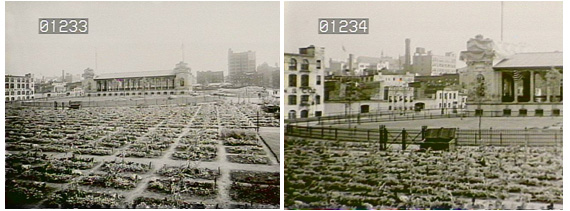 |
Dewitt Clinton Park in October, 1909. Images from the Thomas Warren Sears Collection,
Archives of American Gardens, Smithsonian Institution.
|
A century later, residents in many cities across the United States are again turning to gardening as one form of urban revitalization, community building and place-making, this time in landscapes fractured by the displacement of industry. The challenges of rapid industrialization and urbanization have given way to those of urban disinvestment and “post-industrial” landscapes of vacant lots and abandoned buildings, where the continuing effects of the industrial era (soil contamination, pollution, etc.) and social problems remain. Indeed, Parsons might not have found these landscapes so dissimilar to the environment of her own era. The Archives of American Gardens contains several collections that provide invaluable documentation of these “post-industrial” gardens that began changing urban landscapes as early as the 1970s.
One example is Glenwood Green Acres Community Garden, located in the Susquehanna neighborhood, a low-income section of north central Philadelphia. With a former industrial warehouse in the background, the photograph below bears a striking resemblance to those above. Established in 1984 on the site of a burned down warehouse, the garden is a collaboration between local residents, who saw “this big eyesore across the street” as “the perfect place to start a garden,” and the Pennsylvania Horticultural Society’s Philadelphia Green program. Many of the gardeners are older residents from a variety of backgrounds, who use this place to pass on horticultural and agricultural traditions to younger generations. As journalist Monica Rhor describes in her Philadelphia Inquirer article, “some of the gardeners – African Americans from the South, Puerto Ricans from the island, second- and third-generation Italian Americans – have long called Philadelphia home. Others are relative newcomers from Cambodia, China, Italy, Laos, West Africa. Yet each, in his or her individual way, has infused the city’s greenspaces with fresh tastes and age-old techniques.”
 |
| Glenwood Green Acres Community Garden, Philadelphia, PA, 1996. Ira Beckhoff, photographer. Garden Club of America Collection, Archives of American Gardens, Smithsonian Institution. |
-Joe Cialdella, Intern
Archives of American Gardens
Smithsonian Gardens







I have been trying to set trends regarding private residential gardens in the hot concrete/asphalt urban context of Puerto Rico, USA. I want to share a couple of reviews with your readers.
ReplyDeletehttp://www.guiaverde.com/blog/destacadas/jardin-tropical-en-puerto-rico from Spain and from USA,
http://www.associatedcontent.com/article/7741396/5_gardening_blogs_you_should_read.html?cat=32
My plant botanical name inventory appears in caribbeanbotanicalreview.blogspot.com, mostly collected during me strolls in Santurce and once in a while trips to Guanica, in the south of the island.
X